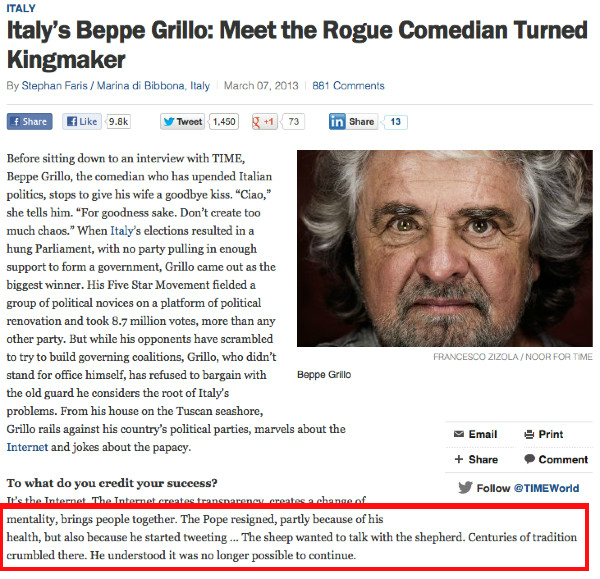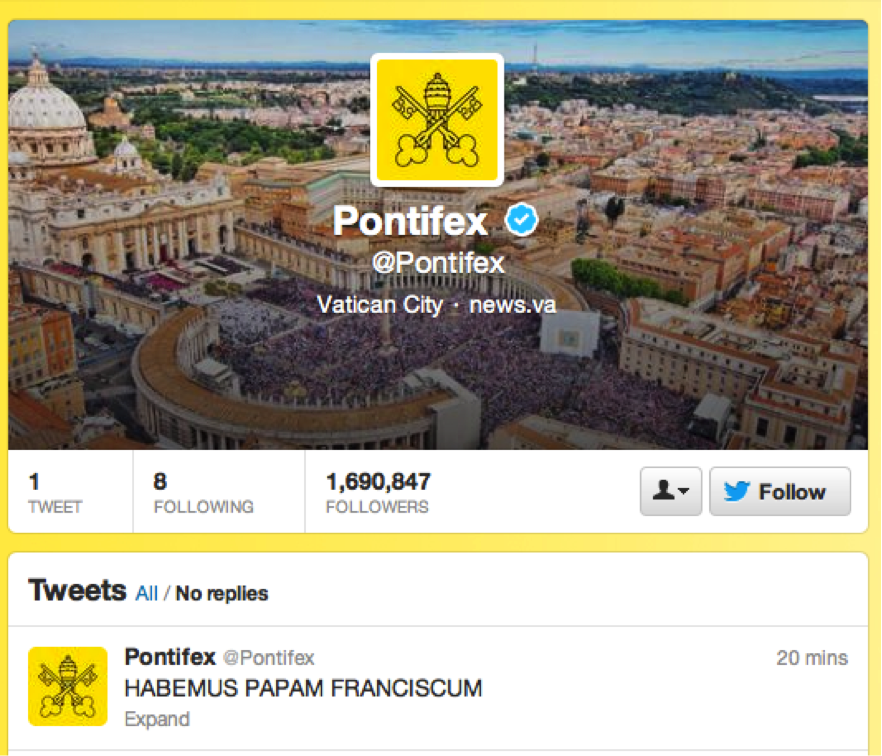On February 2nd, 2013 I wrote this post describing trolling as a defining feature of Pope Benedict XVI’s Twitter presence. After establishing the role of online pontiff-bashing in helping redefine Catholicism, I concluded the Vatican should “feed the trolls”. A week later Joseph Ratzinger resigned. Of course, it’s unrelated. Only an idiot would say there’s a link betweet trolling and papal resignation. And here’s an actual idiot who said just that, in an interview with TIME magazine:
Italian Comedian-Kingmaker Beppe Grillo on Internet and Politics | TIME.com
Soon after the renunciatio, the @pontifex account was semi-discontinued. All tweets uttered in the name of Joseph Ratzinger were deleted, his avatar replaced by the Vatican symbol, the denomination Benedictus XVI supplanted by Sede Vacante (‘Vacant Chair of St. Peter’).
By now, as you know, everything is back to normal, more or less. The cardinals have elected a new Pope, and the pontifical Twitter account is back in the game… with a surprising ALLCAPS message that kind of freaked the hell out of of me.
— Pontifex (@Pontifex) 13 mars 2013
Was it a heartfelt expression of joy at the news? Was it the Vatican Twitter advisors going all informal to mark a radical departure from Benedict XVI’s stuffy brand of microblogging? Or was it the Pope himself imitating his trolls’ verbal approach and style? After all, caps-lock is a basic skill in the art of trolling.
I, for one, would incline to interpret this particular tweet as the starting point of a new phase in the Roman Catholic Church politics of reaching out to its detractors in order to display a tolerant and welcoming face. Establishing a dialogue with critics was one of the staples of the official message for the 47th world communications day, as well as of the Pontifical Council for Social Communications position statement about social networking: trolls might be “far from the Catholic faith”, but they appear to be “on their own quest for the meaning of human life” and the Church has to take into account their “real and urgent requests, as they face doubts and challenges that are consistent with today’s existence”.
This new phase in troll evangelization is one of mirroring, where Papacy tries to convey cultural understanding of its adversaries by adopting their codes and mannerisms. And the trolls are playing along. Mirroring is welcomed by counter-mirroring, where the Pope’s identity is instantly embedded in the utterances of Twitter trolls. Exhibit A: a user mimicks in turn the all-caps papal tweet:
YA TENEMOS NUEVO PAPA!!!!
— Rafael Cardozo (@rafael_el_troll) 13 mars 2013
When mimicking is not enough, we can have actual “mirror-image” where affinity is expressed by inverse symmetry. Here the troll and the Pope are the same, but in reverse:
Pontifex: one who builds bridges.Troll: one who lives under a bridge.
— Savvy Troll (@SavvyTroll) 13 mars 2013
It is but a short step from symmetry to identification. It doesn’t take long for Twitter users to start recognizing (in English, French or Catalan) that the Pope is a troll:
Trolliest pope ever.
— ana australiana (@ana_au_) 13 mars 2013
@jason_a_w a jesuit who eschewed the limos AND was pro-dictatorship and anti-lib-theology is at least a #nichetroll
— ana australiana (@ana_au_) 13 mars 2013
Ahahah, le nouveau pape est un troll de compétition qui vient de foutre en l’air tous les pronostics !
— Andréa Fradin (@FradiFrad) March 13, 2013
El CM de @pontifex esborra del TL tots els tuits anteriors per conservar followers. Tècnica troll de compte zombi.
— Zombi Le Chuck (@zombiLeChuck) March 13, 2013
They elected an Argentinian pope just to troll Thatcher.
— Gordon Henderson (@gordonhenderson) March 13, 2013
Well, this seems like a promising start for new adventures in #trollstudies. Stay tuned for more.
Addendum: Semiotician Valentina Manchia suggests this nice exemple of informal tweeting and cultural code mimicking. Source: The Pontifical Council for Social Communications from the Holy See. Not specifically related to trolling, but I find the choice of posture emoticons rather interesting.
HABEMUS PAPAM o/ o/ o/ o/ o/ o/
— VaticanCommunication (@PCCS_VA) 13 mars 2013

